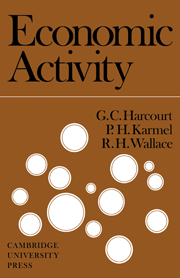Book contents
- Frontmatter
- Preface
- Contents
- 1 INTRODUCTION
- 2 THE NATIONAL ACCOUNTS AND THE INCOME–CREATION PROCESS
- 3 THE PRODUCTION–INCOME–EXPENDITURE CIRCUIT AND NATIONAL ACCOUNTING IDENTITIES
- 4 THE DETERMINATION OF THE EQUILIBRIUM LEVEL OF REAL INCOME
- 5 THE CONCEPT OF FULL EMPLOYMENT
- 6 MONEY IN THE ECONOMIC PROCESS
- 7 THE BANKING SYSTEM AND THE QUANTITY OF MONEY
- 8 THE CONSUMPTION FUNCTION
- 9 THE DETERMINANTS OF INVESTMENT EXPENDITURE
- 10 THE EFFECT OF CHANGES IN EXPENDITURE PLANS: THE MULTIPLIER CONCEPT
- 11 THE GOVERNMENT SECTOR AND THE DETERMINATION OF REAL INCOME
- 12 THE OPEN ECONOMY
- 13 THE INTERACTION BETWEEN PLANNED EXPENDITURES AND FINANCIAL FACTORS
- 14 INFLATION
- 15 ECONOMIC POLICY
- List of suggested reading
- Index
14 - INFLATION
Published online by Cambridge University Press: 18 December 2009
- Frontmatter
- Preface
- Contents
- 1 INTRODUCTION
- 2 THE NATIONAL ACCOUNTS AND THE INCOME–CREATION PROCESS
- 3 THE PRODUCTION–INCOME–EXPENDITURE CIRCUIT AND NATIONAL ACCOUNTING IDENTITIES
- 4 THE DETERMINATION OF THE EQUILIBRIUM LEVEL OF REAL INCOME
- 5 THE CONCEPT OF FULL EMPLOYMENT
- 6 MONEY IN THE ECONOMIC PROCESS
- 7 THE BANKING SYSTEM AND THE QUANTITY OF MONEY
- 8 THE CONSUMPTION FUNCTION
- 9 THE DETERMINANTS OF INVESTMENT EXPENDITURE
- 10 THE EFFECT OF CHANGES IN EXPENDITURE PLANS: THE MULTIPLIER CONCEPT
- 11 THE GOVERNMENT SECTOR AND THE DETERMINATION OF REAL INCOME
- 12 THE OPEN ECONOMY
- 13 THE INTERACTION BETWEEN PLANNED EXPENDITURES AND FINANCIAL FACTORS
- 14 INFLATION
- 15 ECONOMIC POLICY
- List of suggested reading
- Index
Summary
Introduction
The general levels of prices in most advanced countries have risen substantially over the post-war period, but not at a steady rate. For example, in Australia between 1947 and 1952 the consumer price index rose at an annual rate of 9·9 per cent; between 1953 and 1960 at an annual rate of 2·7 per cent; from 1961 to 1963 the rate of increase was only 0·5 per cent. But over the years 1964 and 1965 the annual rate of increase was 4·0 per cent. One of the declared aims of the governments of the advanced countries has been to attain full employment with price stability. The problem of rising prices has been at the forefront of discussion of economic policy by economists, newspaper editors and other commentators. Various groups in the community have been singled out as responsible for rising prices—trade unions, the Arbitration Commission, businessmen with monopoly power.
In this chapter an analysis is made of the forces which cause prices to rise. It is recognized that prices may increase for a variety of reasons, but the term, inflation, is used to describe any situation marked by a rise in the general level of prices. A warning is necessary at the outset. So far discussion has been confined to the forces which determine the positions of equilibrium and, apart from chapter 10, little attention has been given to an analysis of the process by which an economy moves from one equilibrium position to another.
- Type
- Chapter
- Information
- Economic Activity , pp. 267 - 297Publisher: Cambridge University PressPrint publication year: 1967



